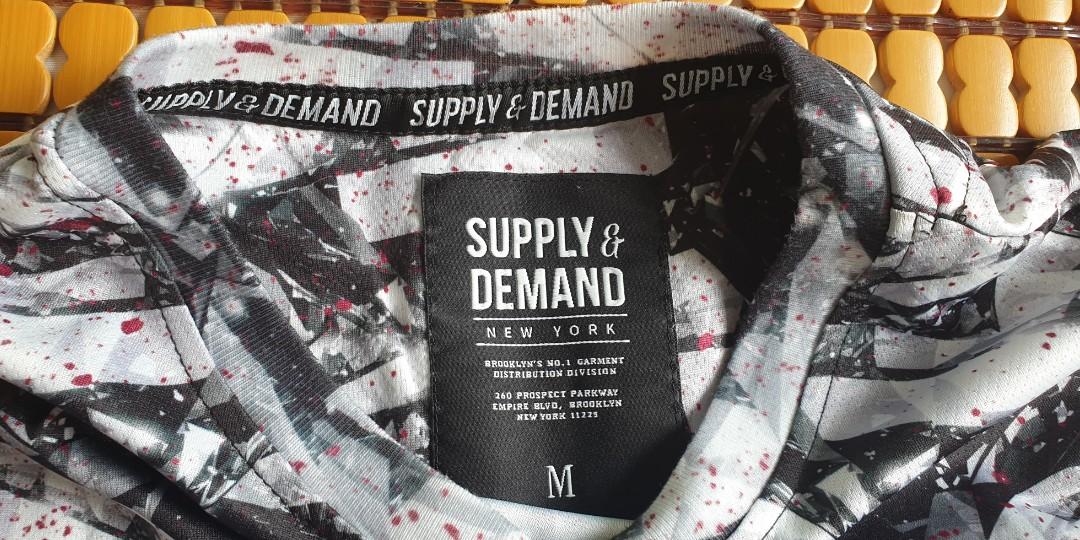Ever wondered why rent in New York feels like it’s straight out of a sci-fi movie? Or why that fancy avocado toast costs an arm and a leg? It all comes down to one simple yet powerful concept: supply and demand new york. This dynamic duo shapes every corner of life in the Big Apple, from housing prices to Broadway tickets. So, buckle up because we’re diving deep into the economic heartbeat of NYC.
New York City is a labyrinth of supply and demand forces. Picture this: millions of people crammed into a relatively small space, all vying for the same resources. Whether it’s apartments, jobs, or even parking spots, the city’s economy thrives—or sometimes struggles—because of how these two factors interact. Understanding this relationship isn’t just for economists; it’s essential for anyone living in or visiting the city.
Supply and demand new york isn’t just a textbook concept here—it’s a way of life. From the bustling streets of Times Square to the quiet corners of Central Park, every transaction, every decision, is influenced by these forces. And as we’ll explore in this article, they’re not just affecting your wallet—they’re shaping the future of the city itself.
Read also:Vivitix Hello Kitty The Ultimate Guide For Fans And Collectors
Understanding the Basics of Supply and Demand
Before we dive into the nitty-gritty of supply and demand in New York, let’s break it down. Simply put, supply refers to how much of something is available, while demand is how much people want it. When supply is high and demand is low, prices tend to drop. But when demand outstrips supply? That’s when things get pricey.
In New York, the scales are often tipped in favor of demand. Think about it: millions of people live here, millions more visit every year, and everyone wants a piece of the action. Whether it’s a cozy apartment in Brooklyn or a front-row seat at a Broadway show, the demand is through the roof.
Key Factors Driving Supply and Demand in NYC
Several factors influence supply and demand in New York. Population growth, for instance, is a major player. As more people move to the city, the demand for housing, jobs, and services increases. But the city’s geography limits how much it can expand, keeping supply relatively fixed.
Economic trends also play a big role. When the economy is booming, people have more disposable income, driving up demand for luxury goods and experiences. Conversely, during economic downturns, demand can drop, leading to lower prices.
Supply and Demand in New York’s Housing Market
Let’s talk about housing. If you’ve ever tried to find an apartment in New York, you know it’s no picnic. The city’s housing market is a prime example of supply and demand in action. With limited space and millions of people competing for homes, prices have skyrocketed over the years.
But it’s not all doom and gloom. Recent trends show a slight shift in the market. With more people working remotely post-pandemic, some are leaving the city for quieter, less expensive places. This has led to a slight increase in supply, which could eventually bring prices down.
Read also:Wellington Couple Shot A Heartbreaking Story That Shocked New Zealand
Challenges Facing the Housing Market
Despite these trends, several challenges remain. Affordable housing is a major issue, with many New Yorkers struggling to find homes they can afford. Developers often focus on luxury properties, leaving fewer options for middle and lower-income residents. Additionally, zoning laws and regulations can stifle new construction, further limiting supply.
- Affordable housing shortages
- Focus on luxury developments
- Strict zoning laws
Supply and Demand in New York’s Job Market
Now let’s turn our attention to the job market. New York is a hub for finance, tech, fashion, and more, making it a magnet for job seekers. But with so many people competing for the same positions, the job market can be fierce.
That said, certain sectors are seeing a surge in demand. Tech companies, for instance, are expanding rapidly, creating thousands of new jobs. This has led to a talent war, with companies offering competitive salaries and benefits to attract the best candidates.
Impact of Remote Work on the Job Market
The rise of remote work has also had a significant impact on the job market. While some companies have embraced it fully, others are hesitant, preferring to keep their teams in the city. This has created a split in the market, with some sectors thriving and others struggling.
For job seekers, this means more options but also more competition. Those who can adapt to the changing landscape are likely to find success, while those who can’t may find themselves left behind.
Supply and Demand in New York’s Tourism Industry
Tourism is a massive part of New York’s economy, and it’s heavily influenced by supply and demand. Millions of visitors flock to the city every year, drawn by its iconic landmarks, world-class museums, and vibrant culture. But with so many people vying for the same experiences, prices can get steep.
That’s where supply comes in. Hotels, restaurants, and attractions are constantly trying to balance supply with demand. Too much supply, and they risk losing money. Too little, and they risk alienating customers.
Seasonal Fluctuations in Tourism
Tourism in New York is also subject to seasonal fluctuations. Summer and fall are peak seasons, with visitors from all over the world flocking to the city. Winter and spring, on the other hand, see a drop in demand, leading to lower prices and fewer crowds.
- Peak seasons: summer and fall
- Off-peak seasons: winter and spring
- Price adjustments based on demand
Supply and Demand in New York’s Food Scene
No discussion of New York would be complete without talking about food. The city’s culinary scene is a melting pot of cultures and flavors, offering something for everyone. But with so many restaurants vying for attention, the competition is fierce.
Supply and demand play a crucial role here. Popular cuisines, like Italian and Mexican, often have more supply than demand, leading to lower prices. Meanwhile, trendy new concepts, like plant-based dining, can command higher prices due to their novelty.
Challenges Facing the Restaurant Industry
Despite its popularity, the restaurant industry in New York faces several challenges. Rising costs for rent and labor, coupled with intense competition, make it difficult for many establishments to survive. Add to that the impact of the pandemic, and you have a recipe for tough times.
But some restaurants are finding ways to thrive. By focusing on unique experiences and high-quality food, they’re able to stand out in a crowded market. And as more people return to dining out, the future looks brighter for those who can adapt.
Supply and Demand in New York’s Arts and Entertainment
New York is a hub for arts and entertainment, from Broadway shows to art galleries. But like everything else in the city, this sector is shaped by supply and demand. With so many productions and exhibitions vying for attention, it can be tough to stand out.
That’s where marketing and branding come in. The most successful shows and exhibitions are those that create a buzz, generating demand through clever advertising and word-of-mouth. But even the best marketing can’t save a production if the supply doesn’t meet expectations.
Impact of Digital Media on Arts and Entertainment
Digital media has also had a significant impact on the arts and entertainment scene in New York. Streaming services and online platforms have changed how people consume content, creating new opportunities for creators and producers. But they’ve also increased competition, making it harder for traditional venues to attract audiences.
Those who can adapt to this changing landscape are likely to find success, while those who can’t may struggle to survive.
Supply and Demand in New York’s Real Estate Development
Real estate development is another area where supply and demand play a crucial role. With limited space and high demand, developers are constantly looking for ways to maximize their returns. This has led to some impressive projects, but also to concerns about gentrification and affordability.
That said, recent trends show a shift towards more sustainable and community-focused developments. As awareness of climate change grows, more developers are incorporating green features into their projects, creating buildings that are not only profitable but also environmentally friendly.
Challenges in Real Estate Development
Despite these positive trends, several challenges remain. High costs for land and materials, coupled with regulatory hurdles, make it difficult for developers to turn a profit. And with so many people competing for the same properties, the market can be unpredictable.
- High costs for land and materials
- Regulatory hurdles
- Unpredictable market conditions
Supply and Demand in New York’s Public Transportation
Public transportation is the lifeblood of New York City, and it’s heavily influenced by supply and demand. With millions of people relying on subways and buses every day, the system is under constant pressure to meet demand. But with aging infrastructure and budget constraints, it’s not always easy.
That’s where innovation comes in. Recent investments in technology and infrastructure are helping to improve the system, making it faster, safer, and more reliable. But there’s still a long way to go, and the city will need to continue investing if it wants to keep up with demand.
Future Trends in Public Transportation
Looking ahead, several trends are likely to shape the future of public transportation in New York. Electric buses, autonomous vehicles, and smart infrastructure are just a few of the innovations that could transform the system. But these changes won’t happen overnight, and they’ll require significant investment and planning.
For now, the city’s transportation system remains a work in progress, but one thing is certain: supply and demand will continue to play a key role in its evolution.
Conclusion: Embracing the Dynamics of Supply and Demand in New York
In conclusion, supply and demand in New York City is a complex and ever-changing dynamic. From housing and jobs to tourism and transportation, these forces shape every aspect of life in the city. Understanding them is key to navigating the challenges and opportunities they present.
So, whether you’re a resident, visitor, or business owner, keep an eye on these trends. They could mean the difference between success and struggle in the city that never sleeps. And remember, the more you know, the better equipped you’ll be to make informed decisions.
Got thoughts on supply and demand new york? Drop a comment below or share this article with your friends. Let’s keep the conversation going and help each other make sense of this dynamic city!
Table of Contents:
- Understanding the Basics of Supply and Demand
- Supply and Demand in New York’s Housing Market
- Supply and Demand in New York’s Job Market
- Supply and Demand in New York’s Tourism Industry
- Supply and Demand in New York’s Food Scene
- Supply and Demand in New York’s Arts and Entertainment
- Supply and Demand in New York’s Real Estate Development
- Supply and Demand in New York’s Public Transportation


